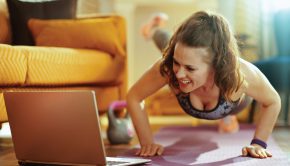Be On the Ball
Putting Extra Fun into Fitness
by Marlaina Donato
Their playful appearance as a beach ball look-alike makes exercise balls welcome props in home workouts, gyms and yoga studios. “They’re a fun training tool for every age, from children to maturing Baby Boomers,” says Dennis Fuchs, CEO of TheraGear, in Sumas, Washington. “Exercise balls are affordable and offer many benefits, from enhanced mobility to reduced risk of injury and increased athletic performance.”
Originally developed by Italian plastic manufacturer Aquilino Cosani in 1963 as a toy called the Gymnastik and then used by British and Swiss physical therapists to help orthopedic patients, the ball has since come a long way to serve fitness needs. Also known as Swiss, stability, balance, physio and Pilates balls, this colorful piece of equipment can range in size from 14 to 34 inches to be appropriate for a user’s height (Tinyurl.com/RightSizeExerciseBall).
Core Strength Without Strain
Stability balls are recommended by fitness trainers and chiropractors for their ability to build core strength and increase flexibility of pelvic muscles without putting unnecessary strain on the back. “The core is a series of muscles used in almost all functional movement; tailored exercises focus both on abdominal and back strength and pelvic and hip stability,” explains Linnea Pond, an exercise instructor at the Pocono Family YMCA, in Stroudsburg, Pennsylvania.
Using an exercise ball also promotes full body conditioning. “Swiss ball training connects the brain with stabilizer muscles, improving gross motor skills and upper body strength, as well,” Fuchs elaborates. “These versatile training balls help equip an individual to handle the functional demands of sports and everyday life.”
Recovery from Injury and Illness
Exercise balls are used in occupational therapy for stroke patients and others recovering from injury. “A stroke deadens part of the brain, and to regain movement in an affected arm or leg, an unaffected part of the brain must take over the lost function. The goal of the therapist is to establish new neural pathways through repetition and visual reinforcement. We have patients do simple exercises with the ball hundreds of times so these pathways start to form,” explains Bob Schrupp, a physical therapist and founder of Therapy Network, in Winona, Minnesota.
One goal for physical and occupational therapists is to help clients perform rehabilitation exercises that also motivate them to continue exercising. While the ball is an excellent tool in clinical settings, Schrupp cautions, “After a stroke, or if you’re older or in poor health, it’s always best to check with your doctor or physical therapist to determine if stability ball exercises are appropriate.”
Pregnant Women and Senior Fitness
Balance balls, when used properly, can offer a safe way for pregnant women, children and seniors to stay fit. Exercising with a ball can help older individuals increase flexibility, especially in the hips, with cardiac strengthening as a bonus.
Pregnant women can safely increase and maintain abdominal strength as the baby grows, and in doing so, care for muscles that will help them through labor. “Pregnancy can throw a woman off balance, and a growing baby puts pressure on internal organs. Pressing the back on a stability ball against a wall offers support for squats. Sitting on a ball helps maintain good posture and pelvic mobility, and reduces low back pain,” explains Pond.
Incorporating the ball into yoga or Pilates routines prompts different muscles into action because it calls on the body’s learned ability to sense and respond to movement, termed proprioception. Pond says, “Proprioception is challenged just from sitting on the ball; there are immediate physical adjustments made to maintain posture and stability. In yoga, the ball is another tool to increase flexibility and balance.”
School and Workplace
Exercise balls are increasingly replacing traditional chairs in classrooms and offices, and teachers are reporting better grades and attention span as a result, while workers appreciate better-toned muscles and enhanced balance. Maintaining good posture by sitting on the ball also increases blood circulation through- out the body, including the brain.
Regarding the equipment’s eye- catching appearance, Schrupp sees a helpful bonus: “The ball is a big, colorful re- minder to perform your exercises.”
Marlaina Donato is a freelance writer, author and multimedia artist. Connect at MarlainaDonato.com
Image: PhotoMediaGroup/Shutterstock.com
<













